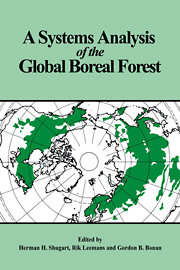Book contents
- Frontmatter
- Contents
- List of contributors
- 1 Introduction
- Part 1 Processes in boreal forests
- Part 2 Patterns in space and time in boreal forests
- Introduction
- 7 The transition between boreal forest and tundra
- 8 The southern boreal–northern hardwood forest border
- 9 Transitions between boreal forest and wetland
- 10 Remote sensing technology for forest ecosystem analysis
- 11 The nature and distribution of past, present and future boreal forests: lessons for a research and modeling agenda
- Part 3 Computer models for synthesis of pattern and process in the boreal forest
- References
- Index
11 - The nature and distribution of past, present and future boreal forests: lessons for a research and modeling agenda
Published online by Cambridge University Press: 12 January 2010
- Frontmatter
- Contents
- List of contributors
- 1 Introduction
- Part 1 Processes in boreal forests
- Part 2 Patterns in space and time in boreal forests
- Introduction
- 7 The transition between boreal forest and tundra
- 8 The southern boreal–northern hardwood forest border
- 9 Transitions between boreal forest and wetland
- 10 Remote sensing technology for forest ecosystem analysis
- 11 The nature and distribution of past, present and future boreal forests: lessons for a research and modeling agenda
- Part 3 Computer models for synthesis of pattern and process in the boreal forest
- References
- Index
Summary
Introduction
The objective of this chapter is to define the properties of a unified boreal forest model. Models are constructed for specific purposes, which themselves guide the selection of, for example, which factors to include, and the level of abstraction and realism. In the case of the unified boreal forest model, certain tasks are obvious and have strongly influenced model construction. Fundamentally we require a model that will permit us to examine long-term forest ecological behavior under a wide range of stable and chronically or catastrophically shifting conditions. However, we can describe more specific tasks for which a boreal simulator is needed.
Most importantly, we lack a vehicle for learning how realistically boreal forests can be defined as abstract ecosystems. Thus, we may wish to develop a mathematical model that can predict forest behavior over both time and space, based on quantitative relations between growth processes and forces intrinsic and extrinsic to boreal forest stands. Construction of the model would simply reflect in part the desire to formulate in testable ways our hypotheses on the importance of various processes that affect the long-term behavior of forest stands. Iterative model construction, comparison of its predictions with field data, further model modification, and so on, allows us to understand what the real forests ‘know’ concerning the processes of interest that the model does not, and to correct the model accordingly. The model may also serve for exploring long-term ramifications of current temporal or spatial vegetation patterns, which are not otherwise intuitively obvious.
- Type
- Chapter
- Information
- A Systems Analysis of the Global Boreal Forest , pp. 291 - 307Publisher: Cambridge University PressPrint publication year: 1992
- 8
- Cited by



